May 2011
- Dave McCormick
- Posts: 2388
- Joined: Fri Mar 16, 2007 8:46 pm
- Location: Co Down, Northern Ireland
- Contact:
Re: May 2011
Well my trapping went bad, only had 2 Muslin moth. However I did find 4 orange-tip eggs on cuckooflowers in the woodland, not far from a 200+ year old Ash tree, making this a new site for them. Seems OTs are spreading and having a very good year. Also found a silver ground carpet on a nettle leaf, first for year. Saw a red squirrel though, they are common around here due to lots of mature oak and beech trees and conifers and the absence of grey squirrels. Saw a male chasing a female up a mature oak tree about 2 weeks ago and saw 5 red squirrel last week. Found lots of eaten acorn shells in the woodland under a 250+ year old oak so there is probably more than one red squirrel about. I didn't stay too long since I was there from 5:30am and now a bit tired and need a rest.
Cheers all,
My Website: My new website: http://daveslepidoptera.com/ - Last Update: 11/10/2011
My Nature videos: http://www.youtube.com/user/DynamixWarePro
My Website: My new website: http://daveslepidoptera.com/ - Last Update: 11/10/2011
My Nature videos: http://www.youtube.com/user/DynamixWarePro
Re: May 2011
Arrived at Aberbargoed Grasslands just before midday in temperatures no better than 12C, accompanied by fresh wind and 80% cloud cover.
The first butterfly I saw was a Small Pearl Bordered Fritillary near the entrance to the site, and there were a couple of Marsh Fritillaries nearby which could barely fly such was the temperature.
Going through the main gate into the site I met up with Michael JF and his wife, Karen, and we spent a good couple of hours wandering cautiously around, occasionally chancing upon a Marsh Frit taking shelter in the long grass. Although they were largely torpid, getting a photo wasn't an easy task due to their propensity to settle low down in the vegetation. There were a few sunny intervals though, and during them the butterflies DID come to life a little.
I would like to come back here on a proper spring day (sunny and 18C+) as I'm sure the Fritillaries would be everywhere. Still, it wasn't a bad return given the weather conditions:
1. Common Blue 20-30
2. Marsh Fritillary 15-20
3. Small Heath 5
4. Dingy Skipper 4
5. Small Pearl Bordered Fritillary 2
6. Large White 2
7. Small Copper 2
8. Brimstone 1
Interestingly, there were NO Green Veined Whites about - they seem to have followed Orange Tips into an early disappearance. Even the numbers of Common Blues had diminished significantly since my last visit 2 weeks ago.
The first butterfly I saw was a Small Pearl Bordered Fritillary near the entrance to the site, and there were a couple of Marsh Fritillaries nearby which could barely fly such was the temperature.
Going through the main gate into the site I met up with Michael JF and his wife, Karen, and we spent a good couple of hours wandering cautiously around, occasionally chancing upon a Marsh Frit taking shelter in the long grass. Although they were largely torpid, getting a photo wasn't an easy task due to their propensity to settle low down in the vegetation. There were a few sunny intervals though, and during them the butterflies DID come to life a little.
I would like to come back here on a proper spring day (sunny and 18C+) as I'm sure the Fritillaries would be everywhere. Still, it wasn't a bad return given the weather conditions:
1. Common Blue 20-30
2. Marsh Fritillary 15-20
3. Small Heath 5
4. Dingy Skipper 4
5. Small Pearl Bordered Fritillary 2
6. Large White 2
7. Small Copper 2
8. Brimstone 1
Interestingly, there were NO Green Veined Whites about - they seem to have followed Orange Tips into an early disappearance. Even the numbers of Common Blues had diminished significantly since my last visit 2 weeks ago.
Re: May 2011
I was at Ryton Wood/Meadows near Coventry this morning with my brood of boys to see what was braving the very windy conditions. Enough sun came through to entice out quite a few butterflies: by far the largest contingent were dingy skippers, with groups of four or five commonplace. Next came Common Blues, Grizzled Skippers and Green Hairstreaks, with one each of Brown Argus, Brimstone, Green-veined White and Orange Tip seen. I spoke to a chap who had seen a solitary Wood White in the woods, and said that elsewhere in the meadow area, the numbers of butterflies were even higher.
Dave
Dave
Re: May 2011
First off this morning I went to my local patch to see if there were any Dingy Skippers about, and found there were at least a couple of individuals getting some early morning sunshine (yes, we were getting some sunshine!  ) on the local Birds-foot Trefoil. There were the usual Common Blues and several moths including the Mother Shipton that distracted me every time they flew, especially when trying to identify the Skippers.
) on the local Birds-foot Trefoil. There were the usual Common Blues and several moths including the Mother Shipton that distracted me every time they flew, especially when trying to identify the Skippers. 
As David M mentioned by lunchtime me and my wife were up at Aberbargoed Grasslands, South Wales. I've become fond of this reserve since visiting it for the first time last year - it's not a big site, but supports some great butterfly species, especially the Marsh Fritillary. Because it's relatively high and has a bit of it's own micro-climate the Mash Fritillaries here are a little behind in emergence times as opposed to South England etc. Anyway, the forecast didn't really end up as good as predicted - we got sunshine, but in blasts of about 10 minutes duration, in between plenty of light grey cloud and a fair bit of wind . So the Marsh Frits were out - as mentioned, probably between 20-30 individuals, but they mostly stayed tucked down in the grass (which is perhaps worryingly dry for this time of the year). I tried a bit of photography with my monopod for an experiment but I'm not sure I'm any the wiser. It was great to meet David M who is great company and has plenty of humour, knowledge and enthusiasm.
. So the Marsh Frits were out - as mentioned, probably between 20-30 individuals, but they mostly stayed tucked down in the grass (which is perhaps worryingly dry for this time of the year). I tried a bit of photography with my monopod for an experiment but I'm not sure I'm any the wiser. It was great to meet David M who is great company and has plenty of humour, knowledge and enthusiasm.
We finished the visit to Aberbargoed investigating the old mining tip which is opposite the reserve. There are some very strange plants & fungi that I should've perhaps taken a few more pictures of. Karen and I quickly re-visited the reserve but the good weather had petered out and the Marsh Fritilaries were even more 'tucked in' than before. So we returned home - where it was still sunny but windy - so I did another quick local walk and again saw a Lackey Moth Caterpilar, this time one that has moved onto the lush ground cover as opposed to Blackthorn that the caterpillar web was originally on about a month back.
Michael
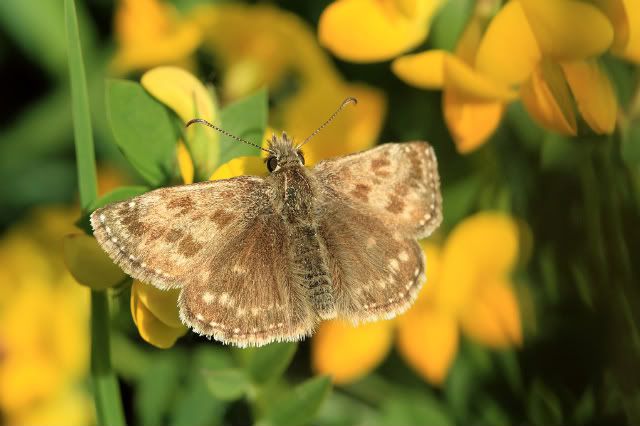
Dingy Skipper on Birds-Foot Trefoil on my home turf.
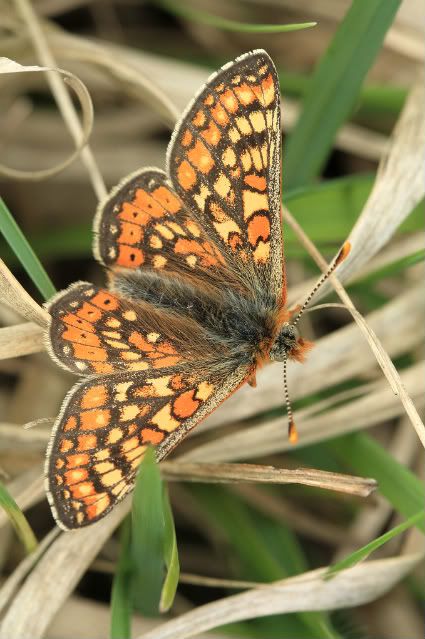
Marsh Fritillary sheltering amongst the grass at the Aberbargoed Grasslands reserve.
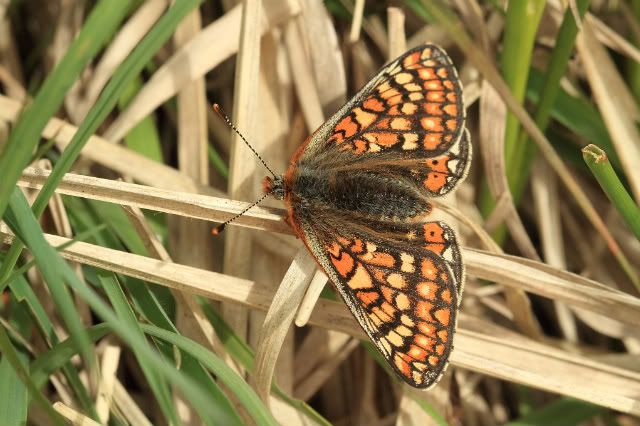
Another Fritillary photo, this one was taken in the longes spell of sunshine...about 10 minutes worth!
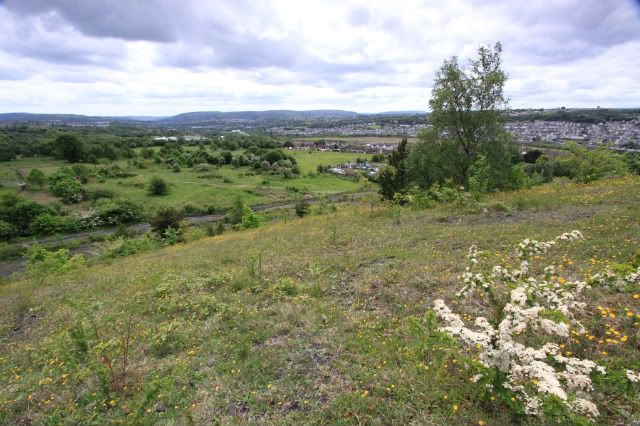
The view from the old mining mounds beside the reserve. The reserve stretches to the left of the picture, the town to the right.
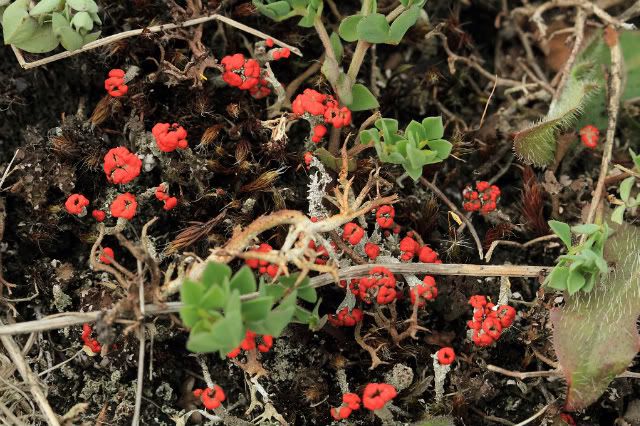
One of the unusual plant / fungi on the old mining heap.
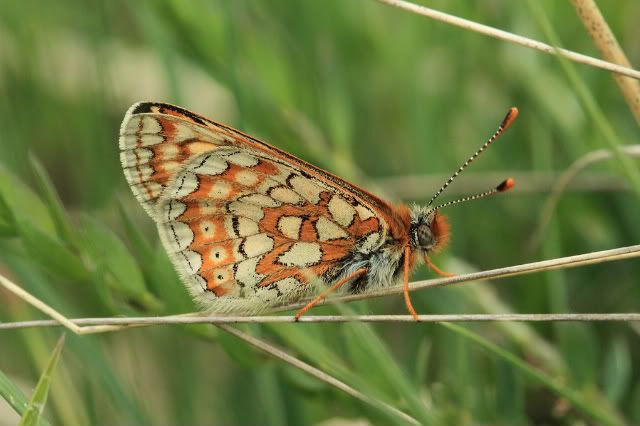
Re-visiting the reserve, the cloud had come over and the Fritilleries were all sheltering.
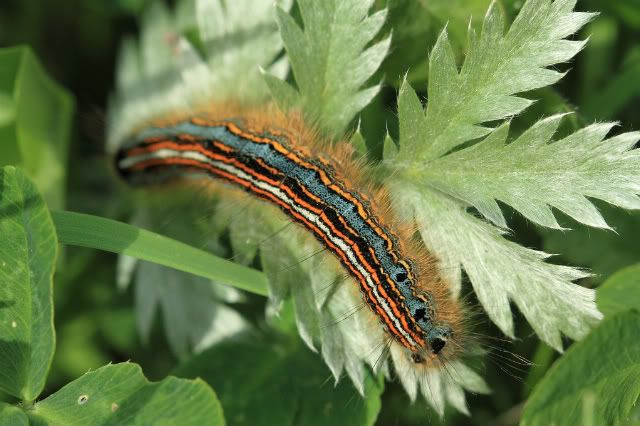
Back home another Lackey Moth caterpillar, this one has moved to the ground cover.
As David M mentioned by lunchtime me and my wife were up at Aberbargoed Grasslands, South Wales. I've become fond of this reserve since visiting it for the first time last year - it's not a big site, but supports some great butterfly species, especially the Marsh Fritillary. Because it's relatively high and has a bit of it's own micro-climate the Mash Fritillaries here are a little behind in emergence times as opposed to South England etc. Anyway, the forecast didn't really end up as good as predicted - we got sunshine, but in blasts of about 10 minutes duration, in between plenty of light grey cloud and a fair bit of wind
We finished the visit to Aberbargoed investigating the old mining tip which is opposite the reserve. There are some very strange plants & fungi that I should've perhaps taken a few more pictures of. Karen and I quickly re-visited the reserve but the good weather had petered out and the Marsh Fritilaries were even more 'tucked in' than before. So we returned home - where it was still sunny but windy - so I did another quick local walk and again saw a Lackey Moth Caterpilar, this time one that has moved onto the lush ground cover as opposed to Blackthorn that the caterpillar web was originally on about a month back.
Michael

Dingy Skipper on Birds-Foot Trefoil on my home turf.

Marsh Fritillary sheltering amongst the grass at the Aberbargoed Grasslands reserve.

Another Fritillary photo, this one was taken in the longes spell of sunshine...about 10 minutes worth!

The view from the old mining mounds beside the reserve. The reserve stretches to the left of the picture, the town to the right.

One of the unusual plant / fungi on the old mining heap.

Re-visiting the reserve, the cloud had come over and the Fritilleries were all sheltering.

Back home another Lackey Moth caterpillar, this one has moved to the ground cover.
Re: May 2011
I got up early yesterday as the weather forecast was good,to go to Bonchurch and Wheelers Bay to see the Glanville Fritillaries. I arrived just after 07.00 and there were a number flying. Some were still roosting from the previous day on valerian which gives a great opportunity for underside shots.
The weather was stunning- blue sky, gentle breeze, sea lapping gently on the shore and amazing visibility. A couple I had met in Norfolk last year at Catfield Fen had contacted me about GFs and were thrilled to find them. Do come to the IOW if you can whilst the GFs are in flight.
PS To see how capable the video is on the Panasonic FZ38, see the following red squirrel video on You Tube http://www.youtube.com/watch?v=mczrp2hWla8
and Adonis blues www.youtube.com/watch?v=37FPiv4vT0Q
The weather was stunning- blue sky, gentle breeze, sea lapping gently on the shore and amazing visibility. A couple I had met in Norfolk last year at Catfield Fen had contacted me about GFs and were thrilled to find them. Do come to the IOW if you can whilst the GFs are in flight.
PS To see how capable the video is on the Panasonic FZ38, see the following red squirrel video on You Tube http://www.youtube.com/watch?v=mczrp2hWla8
and Adonis blues www.youtube.com/watch?v=37FPiv4vT0Q
Last edited by Ian Pratt on Sun May 15, 2011 5:48 am, edited 2 times in total.
- Jack Harrison
- Posts: 4709
- Joined: Wed Jan 18, 2006 8:55 pm
- Location: Nairn, Highland
- Contact:
Re: May 2011
From South Wales:
Jack
What a difference from the east. Here (Cambridgeshire) sunshine totals are 57% above long-term average for first half of May, April was also 57% above average, March was 25% up. And of course, we've had negligible rain now for almost three months.(yes, we were getting some sunshine!)
Jack
-
admiral halsey
- Posts: 83
- Joined: Mon Mar 21, 2011 8:58 am
Re: May 2011
Wicken Fen yesterday, windy and dull much of the time. Only two single sightings, Speckled wood and Red Admiral. Moved on to Anglesey Abbey where I saw the Butterfly below. Being relatively new to this I would like confirmation of the species/sex. It looks like a Wood white with its rounded forewings.
Cheers
Rich Also, totally different, got a lovely shot of a Mayfly at Wicken
Cheers
Rich Also, totally different, got a lovely shot of a Mayfly at Wicken
There is a fine line between uninhibited and asleep
- Pete Eeles
- Administrator & Stock Contributor

- Posts: 6869
- Joined: Tue Jan 17, 2006 6:10 pm
- Location: Thatcham, Berkshire
- Contact:
Re: May 2011
Hi Rich - I'm pretty sure this is a Large White (the only other species it could be is a Small White). Difficult to sex though!
Cheers,
- Pete
Cheers,
- Pete
Life Cycles of British & Irish Butterflies: http://www.butterflylifecycles.com
British & Irish Butterflies Rarities: http://www.butterflyrarities.com
British & Irish Butterflies Rarities: http://www.butterflyrarities.com
- Padfield
- Administrator

- Posts: 8373
- Joined: Sun Nov 05, 2006 10:19 pm
- Location: Leysin, Switzerland
- Contact:
Re: May 2011
Hi Rich,
Wood whites are a very different shape and have quite different venation too (for example, the cell - the 'loop vein' in the basal half of each wing - is tiny).
Your butterfly is a small white - I think a female.
Guy
EDIT - just seen Pete's post, so third opinion needed! I think the impression of the apical patch reaching down the outer margin is an illusion caused by the fringe of the hindwing inside it.
Wood whites are a very different shape and have quite different venation too (for example, the cell - the 'loop vein' in the basal half of each wing - is tiny).
Your butterfly is a small white - I think a female.
Guy
EDIT - just seen Pete's post, so third opinion needed! I think the impression of the apical patch reaching down the outer margin is an illusion caused by the fringe of the hindwing inside it.
Guy's Butterflies: https://www.guypadfield.com
The Butterflies of Villars-Gryon : https://www.guypadfield.com/villarsgryonbook.html
The Butterflies of Villars-Gryon : https://www.guypadfield.com/villarsgryonbook.html
- Jack Harrison
- Posts: 4709
- Joined: Wed Jan 18, 2006 8:55 pm
- Location: Nairn, Highland
- Contact:
Re: May 2011
I go along with Small White.
Wood White sadly does not occur in Cambridgeshire (not sure if it did historically). A Wood White when seen settled is quite unmistakeable. Your nearest place to see one would be for example Wicken Wood (strange that the name should be so similar but there is no connection with Wicken Fen). Wicken Wood is to the west of Milton Keynes. This is a good time of year to see Wood Whites.
Jack
Wood White sadly does not occur in Cambridgeshire (not sure if it did historically). A Wood White when seen settled is quite unmistakeable. Your nearest place to see one would be for example Wicken Wood (strange that the name should be so similar but there is no connection with Wicken Fen). Wicken Wood is to the west of Milton Keynes. This is a good time of year to see Wood Whites.
Jack
- Dave McCormick
- Posts: 2388
- Joined: Fri Mar 16, 2007 8:46 pm
- Location: Co Down, Northern Ireland
- Contact:
Re: May 2011
I'd agree with small white too. Doesn't large white have a fork in one of its top wing veins?
Had a large white in garden a few minutes ago.
Had a large white in garden a few minutes ago.
Cheers all,
My Website: My new website: http://daveslepidoptera.com/ - Last Update: 11/10/2011
My Nature videos: http://www.youtube.com/user/DynamixWarePro
My Website: My new website: http://daveslepidoptera.com/ - Last Update: 11/10/2011
My Nature videos: http://www.youtube.com/user/DynamixWarePro
- Padfield
- Administrator

- Posts: 8373
- Joined: Sun Nov 05, 2006 10:19 pm
- Location: Leysin, Switzerland
- Contact:
Re: May 2011
Both large white and small white have a fork in vein 7, though it is sometimes missing in large white (and very occasionally in small white too). This butterfly has the fork. The feature is very useful for distinguishing between small white and southern small white, which lacks the fork, but doesn't occur in the UK.
Guy
Guy
Guy's Butterflies: https://www.guypadfield.com
The Butterflies of Villars-Gryon : https://www.guypadfield.com/villarsgryonbook.html
The Butterflies of Villars-Gryon : https://www.guypadfield.com/villarsgryonbook.html
- Pete Eeles
- Administrator & Stock Contributor

- Posts: 6869
- Joined: Tue Jan 17, 2006 6:10 pm
- Location: Thatcham, Berkshire
- Contact:
Re: May 2011
Yep - tricked by an illusion! Small White it is!padfield wrote:EDIT - just seen Pete's post, so third opinion needed! I think the impression of the apical patch reaching down the outer margin is an illusion caused by the fringe of the hindwing inside it.
Cheers,
- Pete
Life Cycles of British & Irish Butterflies: http://www.butterflylifecycles.com
British & Irish Butterflies Rarities: http://www.butterflyrarities.com
British & Irish Butterflies Rarities: http://www.butterflyrarities.com
- Dave McCormick
- Posts: 2388
- Joined: Fri Mar 16, 2007 8:46 pm
- Location: Co Down, Northern Ireland
- Contact:
Re: May 2011
Thanks Guy...usually don't try to id those two by photos, easier seeing them and noticing the size, but not very good at IDing via photos large/small whitespadfield wrote:Both large white and small white have a fork in vein 7, though it is sometimes missing in large white (and very occasionally in small white too). This butterfly has the fork. The feature is very useful for distinguishing between small white and southern small white, which lacks the fork, but doesn't occur in the UK.
Guy
Cheers all,
My Website: My new website: http://daveslepidoptera.com/ - Last Update: 11/10/2011
My Nature videos: http://www.youtube.com/user/DynamixWarePro
My Website: My new website: http://daveslepidoptera.com/ - Last Update: 11/10/2011
My Nature videos: http://www.youtube.com/user/DynamixWarePro
-
admiral halsey
- Posts: 83
- Joined: Mon Mar 21, 2011 8:58 am
Re: May 2011
Hello,
15 May 2011
This year the expanse of Horseshoe Vetch, Hippocrepis comosa, on the lower slopes of Mill Hill was extremely disappointing. It was already past its prime and the flowers were only showing about 20% of their usual brilliance after an extended dry spring.
The north-westerly direction of the Moderate Breeze made conditions poor for butterflies on the exposed slope of Mill Hill. Almost all of them were hiding or resting. About 160 Adonis Blues were disturbed as it was too cool and overcast for them to be actively fluttering around. The males were worn and the females looking to lay their eggs amongst the Horseshoe Vetch. On the southern part of Mill Hill, I spotted a handful of my first Common Blue Butterflies of the year.
Mill Hill Reports 2011
http://www.glaucus.org.uk/MillHill2011.html
Mill Hill and its Butterflies
http://www.glaucus.org.uk/MillHill2009Article.htm
First Adur Butterfly Dates 2003 to 2011
http://www.glaucus.org.uk/ButterfliesFFT.htm
Adur Butterfly & Large Moth List
http://www.glaucus.org.uk/Butterfly-list2011.html
Cheers
Andy Horton
glaucus@hotmail.com
Adur Valley Nature Notes
http://www.glaucus.org.uk/Adur2011.html
Adur Valley Nature Notes: April 2011
http://www.glaucus.org.uk/April2011.html
Sussex Downs Facebook Group
http://www.facebook.com/group.php?gid=111843132181316
15 May 2011
This year the expanse of Horseshoe Vetch, Hippocrepis comosa, on the lower slopes of Mill Hill was extremely disappointing. It was already past its prime and the flowers were only showing about 20% of their usual brilliance after an extended dry spring.
The north-westerly direction of the Moderate Breeze made conditions poor for butterflies on the exposed slope of Mill Hill. Almost all of them were hiding or resting. About 160 Adonis Blues were disturbed as it was too cool and overcast for them to be actively fluttering around. The males were worn and the females looking to lay their eggs amongst the Horseshoe Vetch. On the southern part of Mill Hill, I spotted a handful of my first Common Blue Butterflies of the year.
Mill Hill Reports 2011
http://www.glaucus.org.uk/MillHill2011.html
Mill Hill and its Butterflies
http://www.glaucus.org.uk/MillHill2009Article.htm
First Adur Butterfly Dates 2003 to 2011
http://www.glaucus.org.uk/ButterfliesFFT.htm
Adur Butterfly & Large Moth List
http://www.glaucus.org.uk/Butterfly-list2011.html
Cheers
Andy Horton
glaucus@hotmail.com
Adur Valley Nature Notes
http://www.glaucus.org.uk/Adur2011.html
Adur Valley Nature Notes: April 2011
http://www.glaucus.org.uk/April2011.html
Sussex Downs Facebook Group
http://www.facebook.com/group.php?gid=111843132181316
Re: May 2011
I have to say that without the scale in a photograph, I too have made similar mistakes re Large v Small when I have reviewed pics at home....Dave McCormick wrote: Thanks Guy...usually don't try to id those two by photos, easier seeing them and noticing the size, but not very good at IDing via photos large/small whites
Sometimes it is the "easy" ones we can get wrong
"Conservation starts in small places, close to home..."
- Jack Harrison
- Posts: 4709
- Joined: Wed Jan 18, 2006 8:55 pm
- Location: Nairn, Highland
- Contact:
Re: May 2011
Nobody remind me of a Large White/Small White clanger - please.Sometimes it is the "easy" ones we can get wrong
Jack
Re: May 2011
Hello,admiral halsey wrote:Wicken Fen yesterday, windy and dull much of the time. Only two single sightings, Speckled wood and Red Admiral. Moved on to Anglesey Abbey where I saw the Butterfly below. Being relatively new to this I would like confirmation of the species/sex. It looks like a Wood white with its rounded forewings.
Cheers
Rich Also, totally different, got a lovely shot of a Mayfly at Wicken
I would incline towards a small-sized Large White. Not sure though.
Andy Horton
Re: May 2011
Some pictures from Aberbargoed Grasslands on Saturday 14th May:
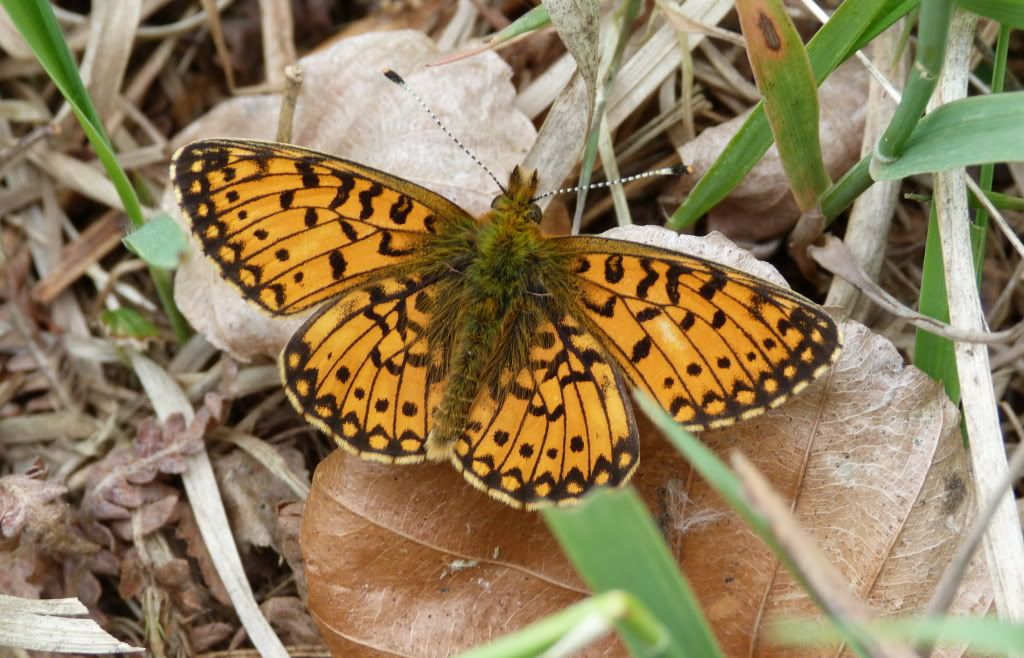
First butterfly seen was a Small Pearl Bordered Fritillary. One other was encountered in a different part of the site.
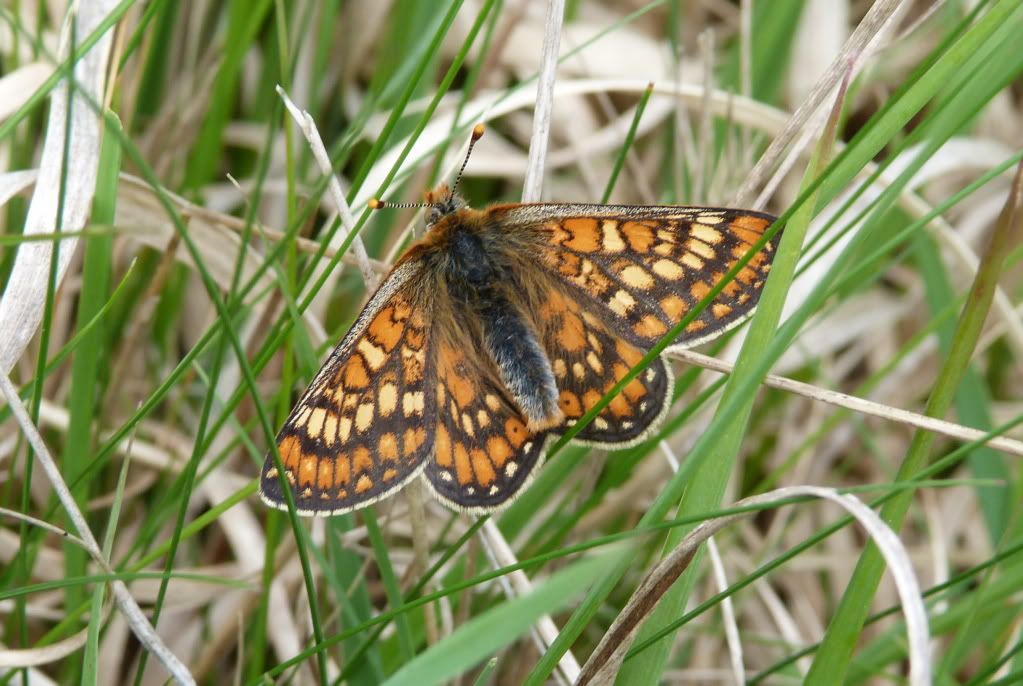
The Marsh Fritillaries were highly approachable but due to the weather weren't keen on emerging from the vegetation.
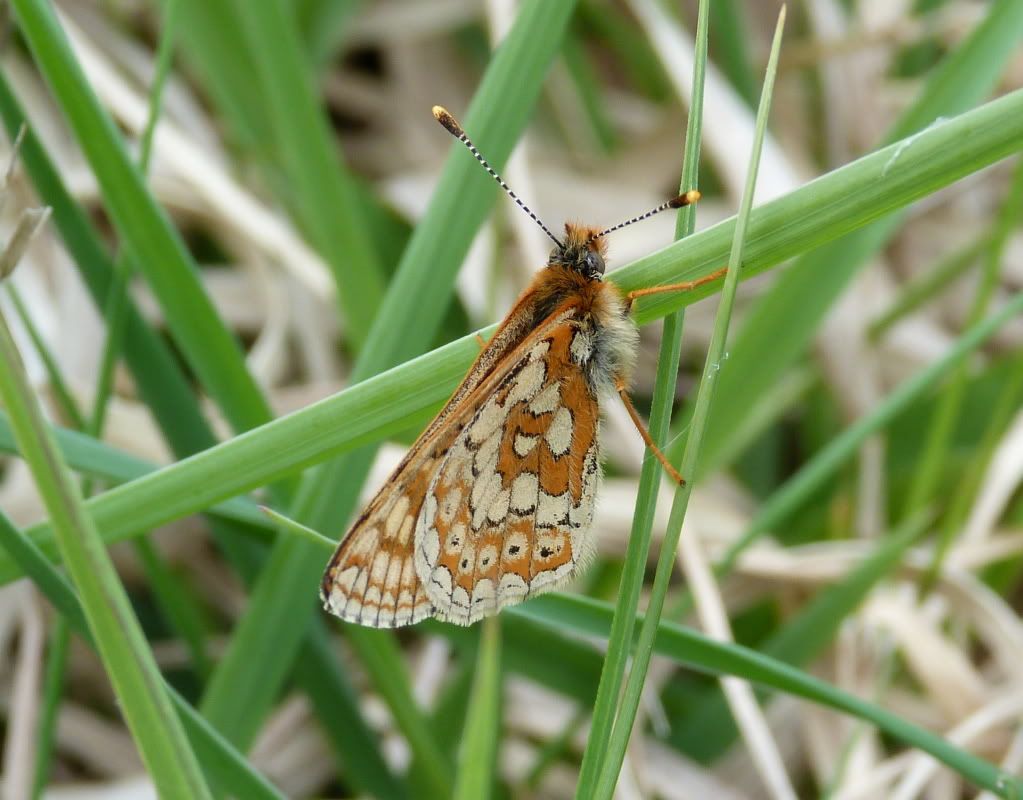
With it being cloudy, quite a few were content to rest wings shut.

First butterfly seen was a Small Pearl Bordered Fritillary. One other was encountered in a different part of the site.

The Marsh Fritillaries were highly approachable but due to the weather weren't keen on emerging from the vegetation.

With it being cloudy, quite a few were content to rest wings shut.
